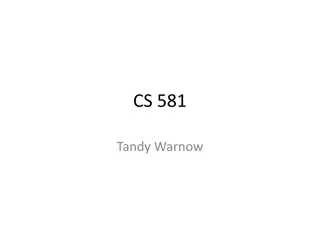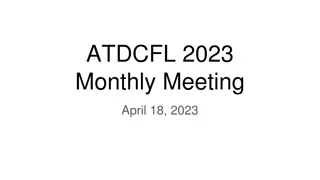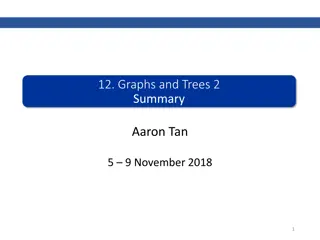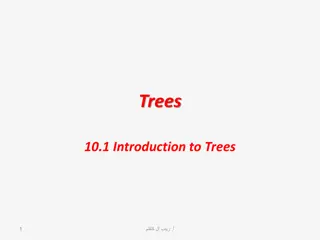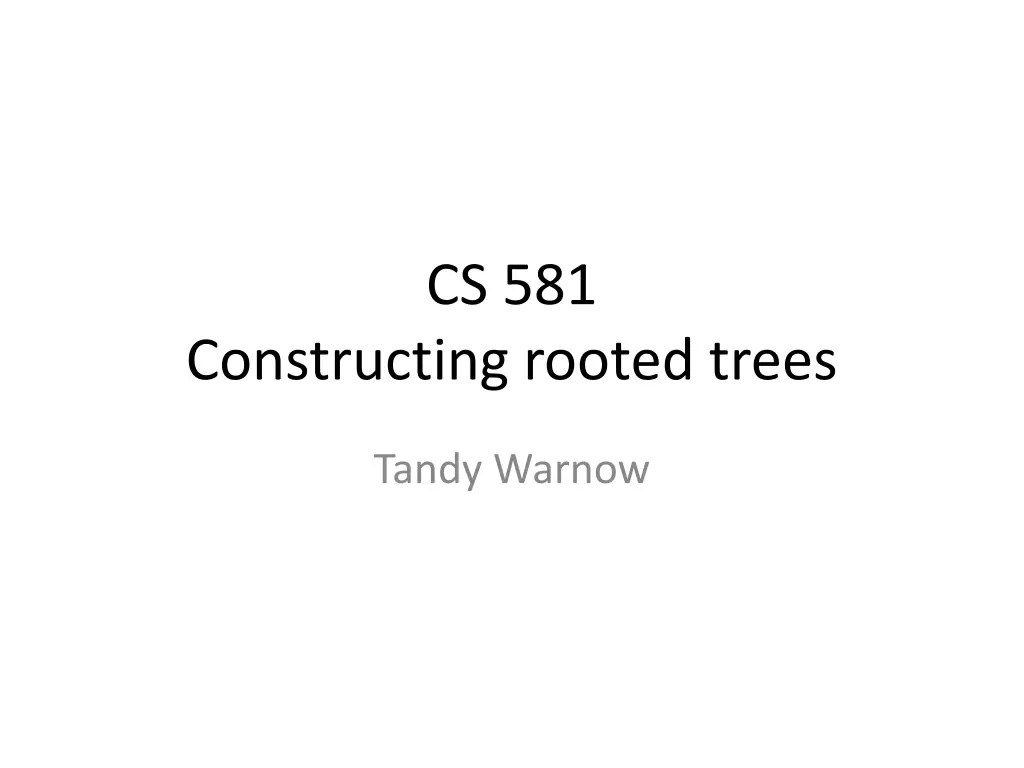
Rooted Trees Construction Techniques in Computer Science
Learn about constructing rooted trees from clades, triplets, and Newick strings. Explore methods using Hasse Diagrams, UPGMA, and more in tree representation. Understand triplet trees and clades in tree construction.
Download Presentation

Please find below an Image/Link to download the presentation.
The content on the website is provided AS IS for your information and personal use only. It may not be sold, licensed, or shared on other websites without obtaining consent from the author. If you encounter any issues during the download, it is possible that the publisher has removed the file from their server.
You are allowed to download the files provided on this website for personal or commercial use, subject to the condition that they are used lawfully. All files are the property of their respective owners.
The content on the website is provided AS IS for your information and personal use only. It may not be sold, licensed, or shared on other websites without obtaining consent from the author.
E N D
Presentation Transcript
CS 581 Constructing rooted trees Tandy Warnow
Todays material Newick strings Representing rooted trees using clades and rooted triplet trees Constructing a rooted tree from its set of clades using Hasse Diagrams Constructing a rooted tree from rooted triplet trees using Aho, Sagiv, Szymanski, and Ullman Constructing a rooted tree from rooted subtrees of any size UPGMA
Todays material Newick strings Representing rooted trees using clades and rooted triplet trees Constructing a rooted tree from its set of clades using Hasse Diagrams Constructing a rooted tree from rooted triplet trees using Aho, Sagiv, Szymanski, and Ullman Constructing a rooted tree from rooted subtrees of any size UPGMA
Newick representations For a rooted tree, we represent it with a string with the taxa, commas, and nested parentheses. For example, what rooted tree is represented by (a,(b,(c,((d,e),(f,g))))))? How do we represent an unrooted tree? (Easy - root it somewhere, and write down the Newick representation of the rooted version.)
Todays material Newick strings Representing rooted trees using clades and rooted triplet trees Constructing a rooted tree from its set of clades using Hasse Diagrams Constructing a rooted tree from rooted triplet trees using Aho, Sagiv, Szymanski, and Ullman Constructing a rooted tree from rooted subtrees of any size
Triplet Trees Definition: Let T be a rooted tree leaf-labelled by S. A triplet tree is a rooted 3-leaf subtree of T, such as ((a,b),c) (also written as ab|c). The set of all triplet trees of T is denoted Triplets(T).
Triplet trees of a rooted tree 6 C 3 = 20 triplet trees ab|c, ab|d, ab|e, ab|f ef|a, ef|b, ef|c, ef|d de|a, de|b, de|c df|a, df|b, df|c cd|a, cd|b ce|a, ce|b cf|a, cf|b
Clades Definition: Let T be a rooted tree leaf-labelled by S, let v an internal node in T, and let Xvbethe set of leaves in T below v. Let Clades(T) = {Xv: v in V(T)}. Note: Xv is also called the cluster at node v, so this is sometimes called Clusters(T).
Clades of a rooted tree Singletons {a}, {b}, , {f} Full set {a,b,c,d,e,f} Non-trivial clades: {e,f}, {a,b}, {d,e,f}, {c,d,e,f}
Constructing trees from clades or triplet trees Problem 1: Given a set of subsets. Is there a tree that has all these subsets as clades? Problem 2: Given a set of triplet trees. Is there a tree that has all the triplet trees? Note (important): We would like a polynomial time algorithm that does not require that we have ALL the clades or ALL the triplet trees.
Computing rooted trees from clades (If necessary): add in the full set S and singletons Partially order the set of clades by containment, and compute the Hasse Diagram of the resultant poset (partially ordered subset) Note: Hasse Diagrams and Partially Ordered Sets are explained in Appendix B in the textbook.
Example: Constructing from clades Algorithm: Construct Hasse Diagram 1. Draw directed graph (nodes are clades, directed edge reflects subset relationship) Given clades X, Y, put an edge X -> Y if X is a proper subset of Y. 2. Remove the unnecessary edges (implied by transitivity, e.g., delete {e,f} -> {c,d,e,f}) What does this graph look like?
Di-Graph for Partially Ordered Set Singletons {a}, {b}, , {f} Full set {a,b,c,d,e,f} Non-trivial clades: {e,f}, {a,b}, {d,e,f}, {c,d,e,f} Red edges can be erased
Hasse diagram! Singletons {a}, {b}, , {f} Full set {a,b,c,d,e,f} Non-trivial clades: {e,f}, {a,b}, {d,e,f}, {c,d,e,f}
Clades of T -> Hasse Diagram -> T Singletons {a}, {b}, , {f} Full set {a,b,c,d,e,f} Non-trivial clades: {e,f}, {a,b}, {d,e,f}, {c,d,e,f}
Clade compatibility Theorem: Let X be a set of subsets of S (containing all singletons and the full set). Then there exists a tree T such that X = Clades(T) if and only if for all A, B in X, either A and B are disjoint, or one contains the other. Proof: One direction is easy. The other direction is slightly harder. Corollary 1: Given X = Clades(T), the Hasse Diagram is T Corollary 2: The Hasse Diagram algorithm answers correctly whether X is a compatible set of clades
Question Suppose I give you an arbitrary set of subsets, and ask you: Is there a rooted tree that has these subsets as clades? Example: {a,b}, {b,c}, {a,b,c}, {a}, {b}, {c} Can you answer this problem correctly? What is the running time?
Small changes Suppose you only have a subset of the non- trivial clades. For example: {a,b},{e,f}, {c,d,e,f} What would happen? What does the HASSE diagram look like? Suppose you have this input: Non-trivial clades: {a,b},{e,f},{d,e,f},{c,d,e,f}, {a,d,e} What would happen? What does the HASSE diagram look like?
Tree construction from clades We presented an algorithm (Hasse Diagram) Questions: Accuracy if given all the clades? Does it always produce binary trees? What if you are missing some clades? (for example, singletons?) What is the running time?
Todays material Newick strings Representing rooted trees using clades and rooted triplet trees Constructing a rooted tree from its set of clades using Hasse Diagrams Constructing a rooted tree from rooted triplet trees using Aho, Sagiv, Szymanski, and Ullman Constructing a rooted tree from rooted subtrees of any size UPGMA
Todays material Newick strings Representing rooted trees using clades and rooted triplet trees Constructing a rooted tree from its set of clades using Hasse Diagrams Constructing a rooted tree from rooted triplet trees using Aho, Sagiv, Szymanski, and Ullman Constructing a rooted tree from rooted subtrees of any size UPGMA
Triplet trees of a rooted tree 6 C 3 = 20 triplet trees ab|c, ab|d, ab|e, ab|f ef|a, ef|b, ef|c, ef|d de|a, de|b, de|c df|a, df|b, df|c cd|a, cd|b ce|a, ce|b cf|a, cf|b
Triplet trees to a rooted tree 6 C 3 = 20 triplet trees ab|c, ab|d, ab|e, ab|f ef|a, ef|b, ef|c, ef|d de|a, de|b, de|c df|a, df|b, df|c cd|a, cd|b ce|a, ce|b cf|a, cf|b Suppose you see only the rooted triplet trees (and maybe not all the rooted trees). I ask: Is there a tree that has all these rooted triplet trees? Can you answer this question correctly, and in polynomial time?
Rooted Tree Compatibility Input: Set X of rooted trees, not all on the same set of leaves. Output: Tree T (if it exists) that agrees with all the trees in X, and otherwise Fail This problem is solvable in polynomial time. Proof: the Aho, Sagiv, Szymanski, and Ullman (ASSU) algorithm!
ASSU Given set of rooted triplet trees, we want to know if there is a rooted tree that agrees with all the triplet trees. Example: ab|c, bc|d, cd|e: YES Example: ab|c, bc|d, ad|c: NO
ASSU Given set of rooted triplet trees, we want to know if there is a rooted tree that agrees with all the triplet trees. Approach: Assume there is a binary tree that agrees with the triplet trees, and try to construct it. Then check.
ASSU Given set of rooted triplet trees, we want to know if there is a rooted tree that agrees with all the triplet trees. Key insight: If xy|z is a triplet tree, then x and y must be on the same side of the root of the binary tree that agrees with xy|z. Why?
ASSU Given set of rooted triplet trees, we want to know if there is a rooted tree that agrees with all the triplet trees. Key insight: Make a graph G=(V,E) with every species a vertex in V and include edge (x,y) if some triplet tree xy|z is in the input. This graph must have at least two components. Why?
ASSU Algorithm: If number of leaves is 2, return sibling pair Else: construct graph (previous slide) If there is only one component, reject and exit (no tree exists) Else: make two groups A and B of taxa (each component in one group) Recurse on each group (only including triplets that are contained within a single group), producing trees TA and TB Return tree obtained by making TA and TB both children of the root
ASSU Try the algorithm on this input: AB|C, BC|D, AD|H, AH|E, EF|G, FG|H Your first graph should have components {A,B,C,D,H} and {E,F,G} When you recurse on {E,F,G} there is only one triplet that matters: EF|G When you recurse on {A,B,C,D,H} the triplets that matter are AB|C, BC|D, and AD|H
ASSU algorithm (alternative version, produces non-binary trees) Given set X of k triplet trees on n species: If n>1, then construct graph with each species one of the vertices, and edges (a,b) for triplets ab|c. If the graph has a single component, reject (the set is not compatible); else recurse on each component, and return tree formed by making the rooted trees on the components each a subtree off the root of the returned tree.
Todays material (from Chapters 1-3) Newick strings Representing rooted trees using clades and rooted triplet trees Constructing a rooted tree from its set of clades using Hasse Diagrams Constructing a rooted tree from rooted triplet trees using Aho, Sagiv, Szymanski, and Ullman Constructing a rooted tree from rooted subtrees of any size UPGMA
Todays material (from Chapters 1-3) Newick strings Representing rooted trees using clades and rooted triplet trees Constructing a rooted tree from its set of clades using Hasse Diagrams Constructing a rooted tree from rooted triplet trees using Aho, Sagiv, Szymanski, and Ullman Constructing a rooted tree from rooted subtrees of any size UPGMA
Compatibility of rooted trees Suppose the input is a set X of rooted trees (not necessarily triplet trees). Can we use ASSU to determine if X is compatible, and to compute a compatibility supertree for X? Solution: YES, just encode each rooted tree in X by its set of rooted triplet trees (or some subset of these that suffices to define each tree in X), and then run ASSU.
Compatibility of rooted trees Suppose the input is a set X of rooted trees (not necessarily triplet trees). Can we use ASSU to determine if X is compatible, and to compute a compatibility supertree for X? Solution: YES, just encode each rooted tree in X by its set of rooted triplet trees (or some subset of these that suffices to define each tree in X), and then run ASSU.
Compatibility of rooted trees Suppose the input is a set X of rooted trees (not necessarily triplet trees). Can we use ASSU to determine if X is compatible, and to compute a compatibility supertree for X? Solution: YES, just encode each rooted tree in X by its set of rooted triplet trees (or some subset of these that suffices to define each tree in X), and then run ASSU.
Todays material (from Chapters 1-3) Newick strings Representing rooted trees using clades and rooted triplet trees Constructing a rooted tree from its set of clades using Hasse Diagrams Constructing a rooted tree from rooted triplet trees using Aho, Sagiv, Szymanski, and Ullman Constructing a rooted tree from rooted subtrees of any size UPGMA
UPGMA The input is a dissimilarity matrix. UPGMA builds a rooted tree from the bottom-up: finds the pair that has the smallest distance, makes them siblings, and recurses . You can turn the tree UPGMA computes into an unrooted tree. Think about what UPGMA does on additive matrices for four leaves.
UPGMA What does UPGMA do on this matrix? What does the Four Point Method do? Is this matrix additive? A B C D A 6 3 7 B 7 11 C 6 D
UPGMA What does UPGMA do on this matrix? What does the Four Point Method do? Is this matrix additive? A B C D A 6 3 7 B 7 11 C 6 D What does this mean about using UPGMA to estimate CFN trees, or JC trees, etc?
Summary of todays lecture We have seen how to construct a rooted tree from its set of clades or triplet trees. We have seen how to test compatibility of a set of clades or rooted trees. We have seen that UPGMA, a method that is designed for rooted tree calculation, can do strange things.
Parting thoughts: Rooted != Unrooted ALSO: Please think about corresponding approaches for unrooted trees. Remember the All Quartets algorithm. What if we only had a subset of the quartet trees? Would it still work?


















